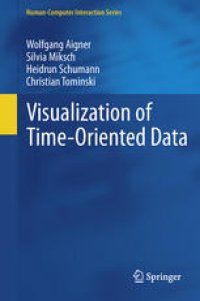
Ebook: Visualization of Time-Oriented Data
- Tags: User Interfaces and Human Computer Interaction, Image Processing and Computer Vision, Information Systems and Communication Service, Computer Applications
- Series: Human-Computer Interaction Series
- Year: 2011
- Publisher: Springer-Verlag London
- Edition: 1
- Language: English
- pdf
Time is an exceptional dimension that is common to many application domains such as medicine, engineering, business, science, biography, history, planning, or project management. Understanding time-oriented data enables us to learn from the past in order to predict, plan, and build the future. Due to the distinct characteristics of time, appropriate visual and analytical methods are required to explore and analyze them.
This book starts with an introduction to visualization and a number of historical examples of visual representations. At its core, the book presents and discusses a systematic view of the visualization of time-oriented data. This view is structured along three key questions. While the aspects of time and associated data describe what is being visualized, user tasks are related to the question why something is visualized. These characteristics and tasks determine how the visualization is to be designed. To support visual exploration, interaction techniques and analytical methods are required as well, which are discussed in separate chapters. The concepts explained in this book are illustrated with numerous examples.
A large part of this book is devoted to a structured survey of existing techniques for visualizing time and time-oriented data. Overall, 101 different visualization techniques are presented on a per-page basis; each of these self-contained descriptions is accompanied by an illustration and corresponding references. This survey serves as a reference for scientists conducting related research as well as for practitioners seeking information on how their time-oriented data can best be visualized in order to gain valuable insights.
Time is an exceptional dimension that is common to many application domains such as medicine, engineering, business, science, biography, history, planning, or project management. Understanding time-oriented data enables us to learn from the past in order to predict, plan, and build the future. Due to the distinct characteristics of time, appropriate visual and analytical methods are required to explore and analyze them.
This book starts with an introduction to visualization and a number of historical examples of visual representations. At its core, the book presents and discusses a systematic view of the visualization of time-oriented data. This view is structured along three key questions. While the aspects of time and associated data describe what is being visualized, user tasks are related to the question why something is visualized. These characteristics and tasks determine how the visualization is to be designed. To support visual exploration, interaction techniques and analytical methods are required as well, which are discussed in separate chapters. The concepts explained in this book are illustrated with numerous examples.
A large part of this book is devoted to a structured survey of existing techniques for visualizing time and time-oriented data. Overall, 101 different visualization techniques are presented on a per-page basis; each of these self-contained descriptions is accompanied by an illustration and corresponding references. This survey serves as a reference for scientists conducting related research as well as for practitioners seeking information on how their time-oriented data can best be visualized in order to gain valuable insights.